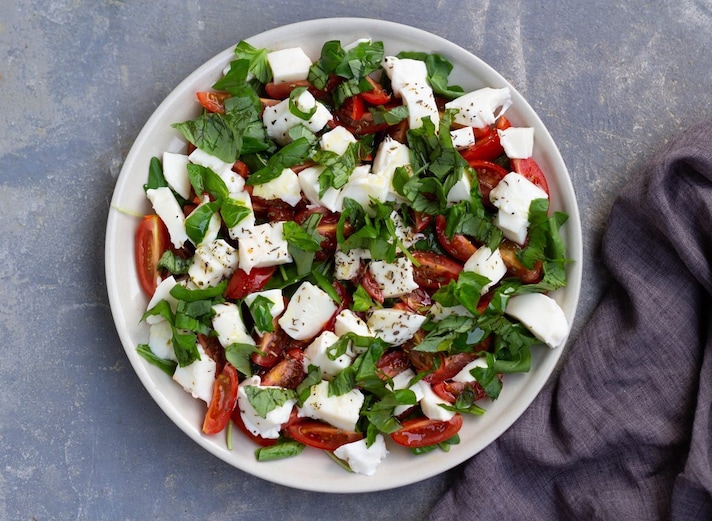Who Invented Salad? Here’s The Reason Why It’s More of a “Concept” Than an Actual Dish
If you think that salad is just a banal side dish, you are very wrong. Its history is a fascinating mix of cultures, traditions and anecdotes, a real journey through time that begins in ancient times.
;Resize,width=742;)
Salad is good for all seasons: it is a comfort food to enjoy when you do not know what to cook or you do not feel like it. But who was the first to think of combining a whole series of vegetables, perhaps adding some protein, to transform vegetables (perhaps not very popular) into a tasty, colorful and flavorful dish?
Obviously there is no real inventor of salad, if we are talking about a dish based on seasoned vegetables accompanied by other elements. However, it is very interesting to understand how we got to the present day, where salad is undoubtedly one of the most consumed dishes in the world with its infinite variations because we note a centuries-long evolution that has led a simple combination of vegetables to become a pillar of world gastronomy. We can calmly say that salad, more than a dish, is a concept that has crossed eras and cultures, continually changing and adapting to the tastes and resources of each era.
It was not invented by a specific person at a specific time, but is the result of a widespread eating habit in many cultures since ancient times. The idea of mixing raw or cooked vegetables with condiments such as salt, oil, vinegar or other ingredients emerged spontaneously in different parts of the world, adapting to the available ingredients and local culinary traditions. More than an invention, therefore, salad is a universal way of preparing food that has taken on different forms over time and place, from the Roman acetaria to modern salads, up to more elaborate dishes such as Caesar Salad or Niçoise.
From Ancient Rome to Caesar Salad
Already in ancient times, the Greeks, Persians and Egyptians consumed raw vegetables, often enriched with spices and aromatic oils, but it was probably the Romans who codified the idea of salad as we know it today. In fact, we have bibliographical evidence of this preparation thanks to Apicius who in his work "De re coquinaria" of the 1st century AD describes dishes of "acetaria", that is, raw vegetables seasoned with vinegar, oil and salt. In Rome, it was a very common habit to consume raw or lightly blanched vegetables, flavored with condiments that could include garum (a fermented fish sauce, the ancestor of anchovy sauce), honey or vinegar. This tradition has been handed down over time, evolving and taking on increasingly refined declinations. The term "salad", which appears in the English language in the 14th century, derives from the Old French word "salade", which also refers to seasoned vegetables.

With the fall of the Roman Empire, salad consumption decreased because strange beliefs began to emerge: doctors of the time were convinced that raw vegetables were harmful to health. It is likely that this idea did not come from conspiracy theories: the Early Middle Ages were a very inauspicious period and bacterial diseases were the order of the day.
Things changed with the first studies on dietetics carried out with a scientific approach in the Renaissance, a period in which Europe and Italy in particular experienced great splendor and exported its cuisine to other European courts. Salads returned to favor and became more elaborate, with the addition of aromatic herbs, dried fruit and refined sauces. Over the centuries, salad has been enriched with new ingredients and condiments, thanks to the creativity of housewives and the availability of garden products. Each region, each culture, has developed its own variations, giving life to an infinite variety of salads.
With the discovery of America, many other unknown products arrived in Europe: with varying fortunes, sooner or later, all were included in these elaborate dishes. Some took centuries to make their way into the hearts of Europeans, such as tomatoes and potatoes, but over time, even vegetables from the New World conquered the tables of the Old Continent.
In the 19th and 20th centuries, with industrialization and the spread of catering, salads became increasingly common dishes, protagonists of refined menus and everyday tables. The real boom was between the two world wars and it is no coincidence that it was precisely in this period that the Caesar Salad was born, one of the most iconic salads in the world, dating back to 1924 even if even today we still do not know for sure who invented it.
At the end of World War II and with the increase in health studies (above all the great study that led to the birth of the Mediterranean Diet ), salad has transformed from a poor dish to a central element in the Western diet. With the growing attention to healthy eating, today it is considered a balanced and versatile choice. It can be a light side dish, a nutritious main course or even a gourmet experience, thanks to the use of high-quality ingredients and creative combinations.
;Resize,width=767;)
;Resize,width=712;)
;Resize,width=712;)
;Resize,width=712;)
